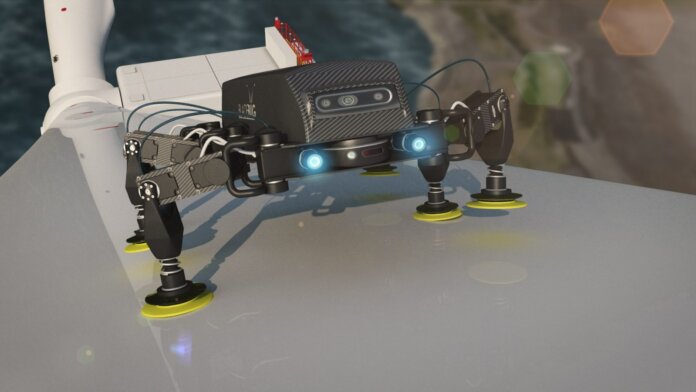The Multi-Platform Inspection, Maintenance and Repair in Extreme Environments (MIMRee) project has reported progress in its end-to-end autonomous inspection and repair demonstration project for offshore wind farms.
MIMRee, awarded a £4.2 million grant from Innovate U.K., is one of offshore wind’s most ambitious robotics projects to date. The end goal is the demonstration of an autonomous system capable of planning its own operational missions to offshore wind farms, whereby a mothership will scan moving turbine blades on approach, then launch teams of inspection drones carrying blade crawlers for forensic inspection and repair of damaged blades.
The Thales imaging system has achieved blur-free images of moving wind turbine blades at the Offshore Renewable Energy (ORE) Catapult’s Levenmouth Demonstration Turbine off the coast of Fife, Scotland. Scanning blades for defects – without stopping turbines for days at a time – is considered a game-changer for wind farm operations.
“This time last year we could talk about a spectacular concept,” says Martin Bourton, project lead at Plant Integrity (PI).
“A year in, we can say that MIMRee is an imminent possibility with a host of technological breakthroughs achieved. The project is developing a variety of spin-off technologies: the ability to scan a working turbine, without stopping it for days while it is inspected, is just one with a very obvious benefit to the industry,” he adds.
The MIMRee mission planning software developed by Professor Sara Bernardini of Royal Holloway University of London has been integrated with the Thales vessel and the inspection drones developed by a team from Manchester and Bristol Universities. The drones have successfully coordinated launch, recovery and navigation from the vessel.
One of the aims of the project is to demonstrate an integrated inspect-and-repair system for wind turbine blades, using the BladeBUG robot, which has recently demonstrated its walking abilities on a variety of blade surfaces at ORE Catapult’s National Renewable Energy Center.
Recently achieved milestones related to the system include:
- An autonomous repair arm, developed by Dr. Sina Sareh’s team at the Royal College of Art Robotics Laboratory, can rapidly switch between modules for cleaning, sanding and top-coating damaged areas of blades, providing real-time feedback visualization and human-in-the-loop teleoperation of repair tasks via a user-interface system
- Following experimentation with visible and short-wave infrared image capturing, PI has produced the blade crawler’s non-destructive testing (NDT) payload. The module uses an advanced machine learning algorithm and a precision scanner for exact measurement of defects under a wide variety of ambient light conditions
- An electronic skin, called Wootzkin, patented by the high-tech robotics company, Wootzano, will enable the robot to feel the surface of the blade. Wootzkin also allows the robot to determine the surface conditions of the blade helping the robot to walk in an extreme environment.
Photo: A virtual rendering of the BladeBUG robot




